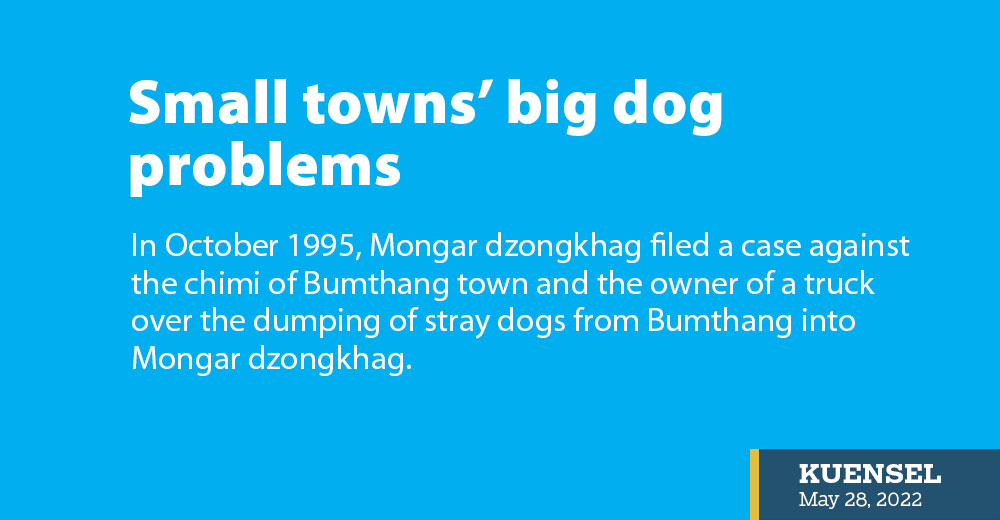Kuensel Reporters
In October 1995, Mongar dzongkhag filed a case against the chimi of Bumthang town and the owner of a truck over the dumping of stray dogs from Bumthang into Mongar dzongkhag. The dzongkhag alleged that about 30 stray dogs, released at Sengor in July, have killed more than 50 sheep belonging to farmers. It alleged that this was the third time stray dogs had been dumped in Mongar. Earlier, dogs were released in Lingmithang and in Ridaza.
Mongar dzongkhag has claimed compensation for the sheep and asked that the dogs be taken back to Bumthang. Meanwhile, a spokesman for Bumthang dzongkhag said that the chimi had denied the allegations.
This situation has been observed in satellite towns in most parts of the country in the past two decades. Even in the capital, dogs were released at the cremation grounds, near monasteries, and schools where they can scavenge on food waste.
Considering the cross-border location, controlling and managing the dog population in Phuentsholing has always been a problem.
Veterinary officials in Phuentsholing said that the town sees two to three rabid cases every year.
Veterinary Dr Sonam Jamtsho said that they conduct dog population control and management every year in Phuentsholing. “But we have to consider the free movement beyond borders and it doesn’t remain in controllable size.”
A Damphu resident, who was also a victim of a dog bite said that when she first came to Tsirang in 2012, the dog population in the town gradually increased over the years peaking between 2018 and 2019.
“There were many reports of dog bites among my friends and family,” she added.
For Mongar town residents stray dogs have been a real menace in the past few years. With the dog population increasing every year, residents say it has become noisy and dangerous.
A town resident, Wangchuk said dogs bark in the middle of the night depriving many of sound sleep.
Residents say most of the stray dogs in the town were those brought from the villages and released in the town.
Mongar eastern regional referral hospital record shows about 100 people from the town and periphery were bitten by dogs and received anti-rabies vaccine from the hospital this year.
Meanwhile, many are banking on the ongoing Nationwide Accelerated Dog Population Management and Rabies Control Program (NADPM and RCP) to resolve the issue.
Residents in Tsirang said that with the introduction of the programme, there has been a decrease in the number of stray dogs.
Tsirang senior livestock officer, Gyem Tshering, said that in four clinics, volunteers and 20 livestock officers were engaged in the programme.
He said that the stray dog population had been increasing in the dzongkhag, causing increased challenges in waste management, a sporadic rabies outbreak, dog bite cases, and some incidents of feral dogs in the villages.
“We aim at 100 percent reduction in the dog population,” he said, adding that residents can raise pet dogs but will have to follow guidelines strictly.
There are more than 3,300 dogs in Tsirang.
During the first phase, over 178 dogs in Phuentsholing were operated on. Dr Sonam Jamtso said it was the sixth day yesterday. “As of today, we have operated 146 dogs in Pasakha areas.”
According to Mongar dzongkhag livestock officials, a total of 3,525 were sterilised in March of which 3,198 were stray dogs and 327 were pets. Livestock officials said from the 4,400 dogs in the dzongkhag, those 442 that could not be caught during the program would be caught with the help of a trap gun and covered in June this year.
Samdrupjongkhar town does not have fewer issues related to stray dogs. The town also has fewer dog bite cases. However, residents said the stray population is increasing.


